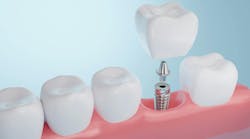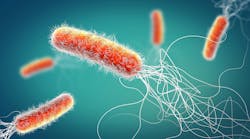Emerging threat: Pseudomonas aeruginosa and dental implant longevity: Part 2
What you'll learn in this article
- How Pseudomonas aeruginosa’s biofilms, toxins, and antibiotic resistance accelerate peri-implant bone loss
- Why detecting P. aeruginosa in implant infections is difficult—and which advanced diagnostic tools are essential
- Emerging prevention and treatment strategies, including phage therapy, implant coatings, and quorum-sensing inhibitors
- Why elderly patients with implants face higher infection risks—and how the dental team can support their care
Editor's note: This is part two of a two-part series. Read part 1.
In part one of this series, we learned about how peri-implantitis is associated with a complex microbial ecosystem that includes Pseudomonas aeruginosa (P. aeruginosa), a pathogen that is not often discussed. This adaptable bacterium forms strong biofilms, resists antibiotics, and accelerates bone loss, posing a significant challenge in implant dentistry.
This month, we will analyze the array of virulence factors of P. aeruginosa, the challenges associated with its detection, the increasing concerns regarding antibiotic resistance, and the emerging approaches that may provide advantageous solutions.
P. aeruginosa engages several virulence factors to establish infections, which include exotoxins (e.g., ExoS and ExoU), proteases, quorum-sensing systems, and adhesion factors. P. aeruginosa produces exotoxins such as ExoS and ExoU, as well as proteases, which can lead to cell death, inhibit phagocytosis, induce apoptosis, disrupt immune responses, and damage host cell membranes. These enzymes also degrade collagen and other structural proteins, causing tissue damage. Some proteases even break down host proteins and inactivate immune components like immunoglobulins (antibodies, specialized proteins produced by immune cells called B lymphocytes). Adhesion factors, including pili and fimbriae, help P. aeruginosa attach to host cells and surfaces, whether they are epithelial cells or medical devices. Flagella aid in motility and also serve as an adhesion factor, facilitating attachment to host tissues.
P. aeruginosa’s role in biofilm
In chronic infections, P. aeruginosa produces an exopolysaccharide called alginate, which forms biofilms. These biofilms provide protection against immune responses and antibiotics, contributing to the persistence of the infection.1 P. aeruginosa produces siderophores, like pyoverdine and pyochelin, which are high-affinity iron-chelating molecules. These siderophores scavenge iron from the host, which is crucial for bacterial growth and survival, particularly in iron-limited environments. P. aeruginosa utilizes a cell-to-cell communication system known as quorum sensing to coordinate the expression of virulence factors. This system allows the bacteria to regulate the production of toxins and other factors that contribute to immune evasion and infection.2
The World Health Organization (WHO) classifies P. aeruginosa as a critical priority pathogen due to its resistance to multiple antibiotics. Carbapenems are a highly effective class of antibiotics, usually reserved for known or suspected multidrug-resistant (MDR) bacterial infections and unfortunately showing resistance to P. aeruginosa. Some of the resistance mechanisms, such as efflux pumps, beta-lactamase production, and biofilm-mediated tolerance, pose significant challenges in clinical management. Think of efflux pumps as tiny pumps in the bacterial cell wall that actively push antibiotics out of the cell before they can work. Beta-lactamases are enzymes made by bacteria that break down certain antibiotics (like penicillins or carbapenems). It’s similar to the bacteria having scissors to cut the antibiotic and render it useless. Biofilms build a fortress that help hide bacteria from antibiotics and the immune system, making it harder for antibiotics to reach and kill them.
Diagnostic challenges
Detecting P. aeruginosa in peri-implant infections presents diagnostic challenges, as its presence may be masked by interactions with other microorganisms. Advanced microbial culture techniques or molecular diagnostics are essential for accurate identification. Emerging therapies for localized infections include antibiotic-loaded implant coatings and targeted drug delivery systems, while systemic infections often require combination antibiotic therapy guided by susceptibility testing. These approaches aim to overcome the bacterium’s resistance mechanisms and biofilm-associated challenges. Researchers are actively exploring several promising avenues for combating P. aeruginosa infections, including phage therapy, which utilize viruses to lyse bacteria; the development of quorum-sensing inhibitors to disrupt bacterial communication and virulence; cytokine therapy to modulate the host immune response; and vaccine development to prevent infection. Understanding its mechanisms of pathogenicity and clinical impact is important for developing effective prevention and treatment strategies. Advances in diagnostics, antimicrobial technologies, and host-targeted therapies hold promise for mitigating the burden of P. aeruginosa-associated infections.
Effects on dental implants
As the elderly population with dental implants continues to grow, many questions are now being raised regarding access to care. This demographic often resides in skilled nursing facilities, nursing homes, assisted living, or memory care facilities. How frequently can these patients receive professional prophylactic treatments to minimize complications? Do they have the financial resources to afford procedures? What is the practicality of maintaining one dental implant, let alone an All-on-4, with limited dexterity or cognitive decline? What are the implications if an implant screw becomes loose or an infection arises? The leading cause of death in this demographic is pneumonia and lower respiratory infections, and oral bacteria have been identified as a contributing factor. Additionally, P. aeruginosa—a highly virulent and often antibiotic-resistant pathogen—is both a major cause of pneumonia and a contributor to implant failure.3
The presence of this bacteria increases the risk of complications, emphasizing the need for diligent monitoring and specialized care for elderly patients with implants. Ensuring proper implant maintenance and timely interventions in all populations, especially this vulnerable group, presents a challenge and will require collaborative efforts from dental professionals, health-care providers, and caregivers to develop practical solutions for long-term implant success.
Editor's note: This article appeared in the July 2025 print edition of RDH magazine. Dental hygienists in North America are eligible for a complimentary print subscription. Sign up here.
References
- Leid JG, Willson CJ, Shirtliff ME, Hassett DJ, Parsek MR, Jeffers AK. The exopolysaccharide alginate protects Pseudomonas aeruginosa biofilm bacteria from IFN-gamma-mediated macrophage killing. J Immunol. 2005;175(11):7512-7518. doi:10.4049/jimmunol.175.11.7512
- Simanek KA, Paczkowski JE. Resistance is not futile: the role of quorum sensing plasticity in Pseudomonas aeruginosa infections and its link to intrinsic mechanisms of antibiotic resistance. Microorganisms. 2022;10(6):1247. doi:10.3390/microorganisms10061247
- Restrepo MI, Babu BL, Reyes LF, et al. Burden and risk factors for Pseudomonas aeruginosa community-acquired pneumonia: a multinational point prevalence study of hospitalised patients. Eur Respir J. 2018;52(2):1701190. doi:10.1183/13993003.01190-2017
About the Author

Anne O. Rice, BS, RDH, CDP, FAAOSH
Anne O. Rice, BS, RDH, CDP, FAAOSH, founded Oral Systemic Seminars after over 35 years of clinical practice and is passionate about educating the community on modifiable risk factors for dementia and their relationship to dentistry. She is a certified dementia practitioner, a longevity specialist, a fellow with AAOSH, and has consulted for Weill Cornell Alzheimer’s Prevention Clinic, FAU, and Atria Institute. Reach out to Anne at anneorice.com.


